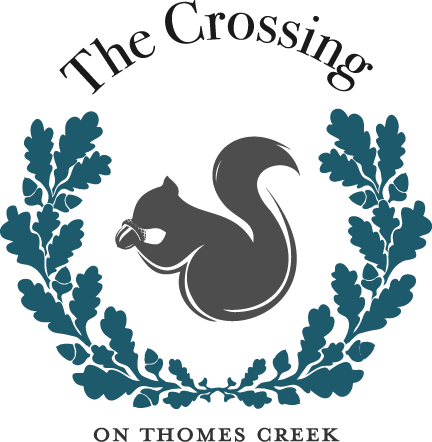More Than A Venue
How The Crossing on Thomes Creek Came By Its Name
In 1870, our family purchased property around the Flournoy/Gleasonville area. They built homes, raised families and worked the land. By all standards it was a good life. The area lent itself to farming and ranching. Pear and peach orchards were planted, irrigated ground developed, sheep, cattle, horses and mules were raised, gardens were grown and a few milk cows milked.
Dry-land grain farming was a large part of the operation. Hundreds of acres of grain were grown yearly and harvested by combines drawn by teams of up to 40 mules. It was exceeding hard, hot work. In the early years, burlap sacks were filled with grain and stitched closed by hand. In the 1920’s, large corrugated metal bins began to replace burlap sacks for grain storage. Mule power gave way to tractors.

As the ranch prospered, it grew in size. Around 1920, the family purchased land near where the historic Butte Mountain Road crossed the waters of Thomes Creek near Gleasonville. For many years, this old road served as a stagecoach and wagon trail which connected the communities of Paskenta and Flournoy to the growing communities of Corning and Orland. Longtime residents referred to this spot on the creek as “the crossing”.
Historically, high water during the winter made it impossible to cross Thomes Creek by wagon or stagecoach. In order to provide safe passage across the creek, a cable suspension footbridge was built and anchored between two oak trees growing on opposite sides of the creek. These two giant oaks still grow and thrive today and remnants of the heavy cable can still be seen.

Gleasonville was established in 1868, not far from “the crossing”. John Gleason built a large two-story hotel, along with a barn to serve as a stage stop and additional buildings to house a blacksmith shop, a dance hall and a saloon. A post office was established in 1872. For many years Gleasonville was a small but thriving town.
Giving a nod to the early history of the area where generations worked, lived and raised families, we felt “the crossing” was a very fitting name for our beautiful venue.
Today, our family holds tight to 350 acres along Thomes Creek. The land is still dotted with scattered blue and valley oaks, riparian areas and open fields. It is home to deer, wild turkey, coyotes and numerous other animals and birds.
The venue reflects our passion to keep the surrounding landscape as natural as possible and to preserve its rustic beauty and history. As you tour the venue, you will see corrugated metal grain storage bins moved from the old Vina Pellet Mill, reclaimed wood beams, wood siding and tin roofing from a historic barn in Weaverville, hand split cedar post fencing from the Judy and Flournoy ranches and a small bridge built using the old suspension foot bridge cable.
It has always been our joy to share this unique area with old and new friends. It is now our pleasure and privilege to share The Crossing on Thomes Creek with you as you celebrate life’s special moments, from wedding receptions and ceremonies to family reunions.

